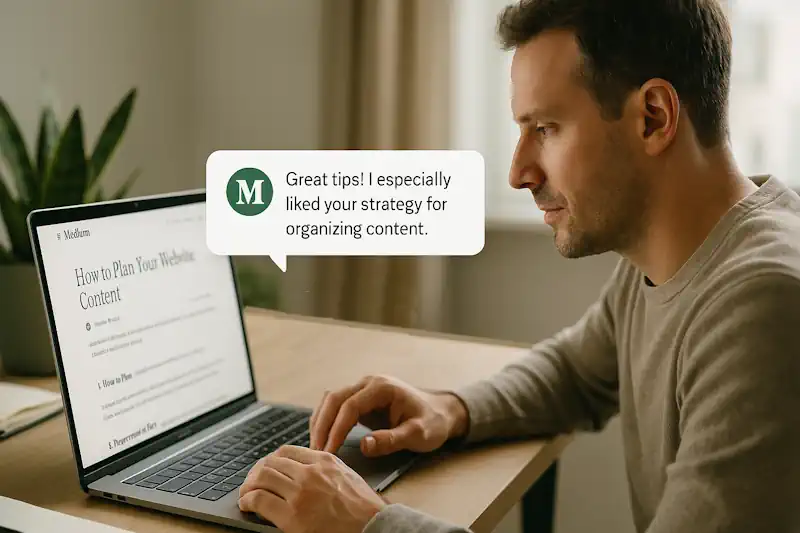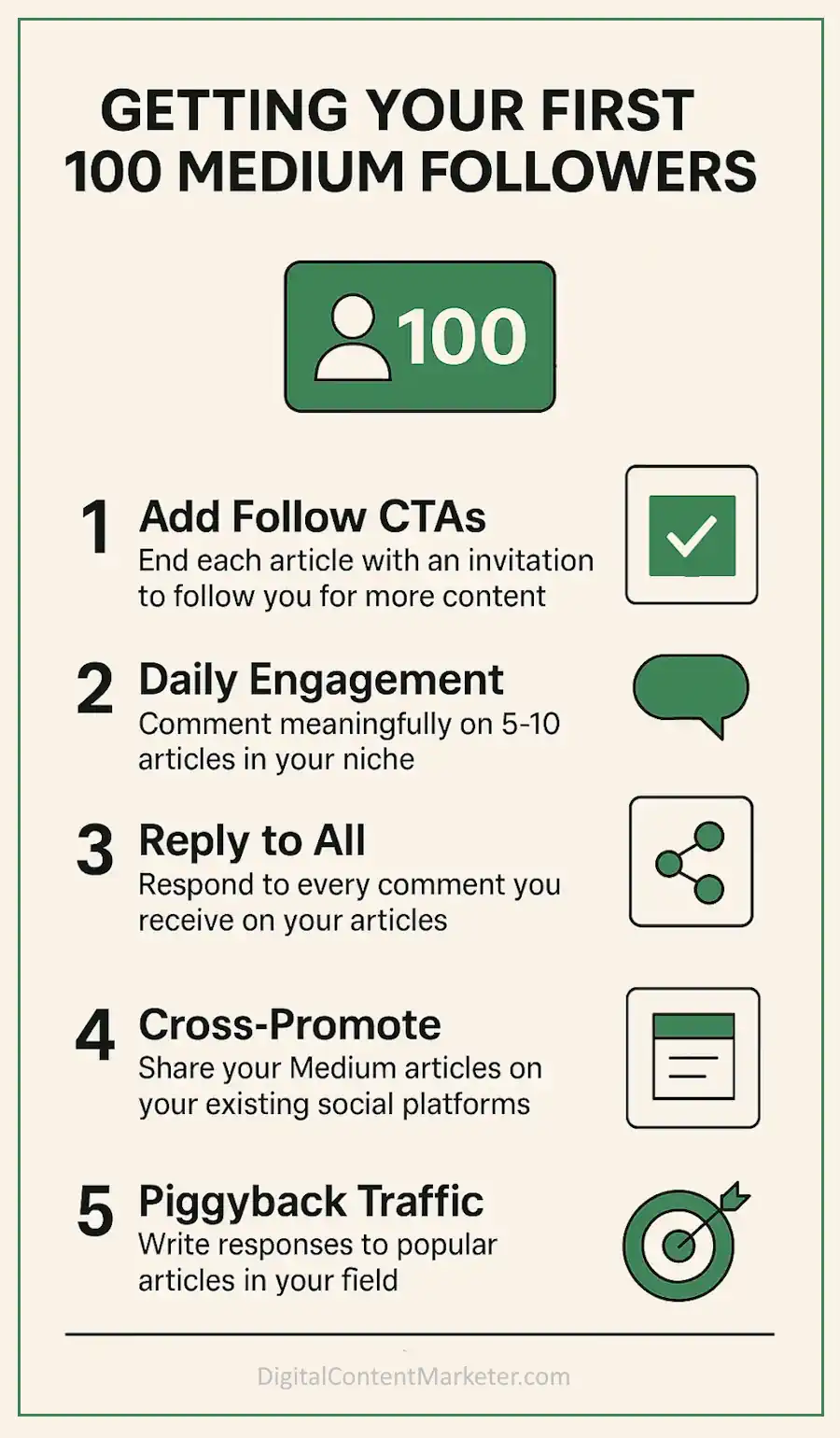There’s a specific set of actions taken by Medium’s most successful writers in their first week on the platform that virtually guarantees they’ll build an audience. This preparation process has nothing to do with writing talent and everything to do with understanding the platform’s unique ecosystem before publishing your first story.

So, before you hit “Create Account” on Medium, take a few minutes to understand how the platform actually works. This isn’t just another writing app or publishing tool. It has its own rhythm, its own logic, and a culture that rewards creators who play smart from the start.
If you treat Medium like a dumping ground for promotional articles or half-baked posts, it will ignore you. But if you understand how to set things up with intention, it can turn into a magnet for readers, leads, and brand recognition.
Creating Your Profile with Purpose
Starting your account is quick, but how you set it up matters. When you create your profile, you’re choosing more than a name and photo. You’re defining how people will see you.
Your bio isn’t filler. It’s the first thing readers check when they like something you wrote. Keep it short, but give people a reason to care. Let them know what you write about and why they should follow you.
Include a link to your site or lead magnet if you want to drive traffic. If you’re using a pen name, make sure your photo still feels real and approachable. If you’re using your real name, use a consistent image across platforms so people can recognize you outside of Medium.
Navigating Medium’s Clean Interface
The platform itself is clean and simple, but there’s more under the surface. Once you log in, the homepage is built around your interests. Medium asks what topics you care about and then fills your feed with articles in those areas.
The more you read and interact, the smarter the recommendations get. Use the search bar to find more specific content or creators. Tags at the bottom of articles help you explore related topics.
Click around. Get a feel for how people write and what kinds of posts rise to the top. You’ll start to notice patterns in style, structure, and tone that you can use in your own writing.
Understanding Medium’s Social Ecosystem
Medium is social, but it doesn’t look like social media. You don’t need to follow people back. There’s no public feed of followers’ comments. But the platform does track what you read, highlight, and clap for.
These signals shape your experience and also affect how Medium sees you as a user. Follow writers who create content in your niche. Follow publications that align with your goals.
These aren’t just content sources. They’re potential collaborators, promoters, and stepping stones to wider exposure. When you engage with their work—by clapping, highlighting, or leaving smart comments—you show up on their radar.
The Value of Thoughtful Comments
The comment section on Medium isn’t a wasteland of trolls or spam. It’s usually thoughtful and respectful, especially in business, tech, or writing niches. Commenting is a subtle form of networking here.
You don’t need to be clever or controversial. Just say something useful, add to the conversation, or show appreciation. If you do it regularly, people will notice you. Some will check out your profile.
Some will follow you. It’s an organic way to grow your audience without being promotional.

Should You Invest in Medium Membership?
Medium membership is optional, but it changes how the platform behaves for you. Without it, you can only read a limited number of articles per month that are behind the paywall. With it, you get unlimited access. If you’re serious about using Medium as a growth tool, it makes sense to invest in the membership.
Not just to read more but to understand what top-tier content looks like. That insight is valuable. You’ll see how the best writers structure their stories, how they keep attention, and how they weave calls-to-action without sounding like ads.
Membership also matters if you plan to earn money through Medium’s Partner Program later. Medium favors content that keeps paying members engaged. If you’re one of those members, you’ll see firsthand which stories get picked for curation and which get buried. You’ll understand what kind of writing actually works here. That context gives you an edge.
Mastering Medium’s Minimalist Editor
Navigating Medium is different from navigating something like WordPress. You don’t need a dashboard full of tools and menus. The editor is minimal and intuitive. You can write directly in the browser or paste in content from elsewhere.
Formatting is simple: headers, bold, italics, links, and images. It won’t overwhelm you with options, but that means you need to focus on clarity and flow. You can’t hide behind fancy layouts or design hacks. Your words have to carry the weight.
Why Engagement Is a Two-Way Street
It’s easy to forget this, but Medium is a two-way street. If you want people to read your work, you need to be part of the ecosystem. That means reading, interacting, and paying attention to what others are doing.
When you’re starting out, spend time exploring the platform. Don’t just write and log out. Look at what gets traction. Take notes. Every click, highlight, and follow are part of the engine that runs the platform.
Setting Up Your First Publication Schedule
Consistency is key on Medium. Readers and the algorithm both respond better to writers who show up regularly. Here’s a simple starter schedule for your first month:
- Week 1: Publish your first article and spend time reading, following, and commenting in your niche
- Week 2: Publish your second piece while continuing to engage daily
- Week 3: Analyze what worked in your first two pieces and publish a third article based on those insights
- Week 4: Reach out to a publication that aligns with your content and submit your fourth article
This pattern helps you build both content and connections simultaneously, giving you a stronger foundation than just focusing on writing alone.
Tags and Distribution Settings
When publishing, don’t overlook your distribution settings and tags. Medium allows you to select up to five tags for each story, which helps categorize your content and make it discoverable.

Choose tags that balance popularity with relevance—extremely popular tags mean more competition, while obscure ones mean less visibility. Look for that sweet spot where the tag has a decent following but isn’t oversaturated.
Also, pay attention to your distribution settings. You can choose to make your story eligible for further distribution through Medium’s curation system, which can significantly increase your reach.
Key Metrics to Track from Day One
Even with your first article, start paying attention to the metrics Medium provides:
- Views: How many people saw your article
- Reads: How many actually read it (the read ratio is particularly important)
- Read time: How long people spent with your content
- Fan ratio: What percentage of readers became followers
These early metrics will help you understand what resonates with Medium’s audience and allow you to adjust your approach accordingly.
Getting Your First 100 Followers
Building your initial audience on Medium requires intentional effort. Here are targeted strategies for your first 100 followers:
- Include a line at the end of each article inviting people to follow you for more on your specific topic
- Engage meaningfully with 5-10 articles in your niche daily
- Respond to every comment you receive
- Share your Medium articles on other platforms where you already have connections
- Consider writing a response to a popular article in your field to tap into existing traffic
These focused actions will help you build momentum more quickly than simply publishing and hoping for the best.

Medium isn’t complicated, but it does reward those who understand its flow. Set up your profile with care. Engage with intention. Watch how the top voices operate. This isn’t just about getting your articles online. It’s about stepping into a space where writing has weight, and where the right foundation can turn a quiet start into a powerful presence.
This was part 4 in our Medium marketing series. Next in our series: Profitable Medium Topics: Strategic Niche Selection for Writers– Find the perfect content focus for maximum impact and engagement. Or return to the intro and the full series’ Table of Contents.

